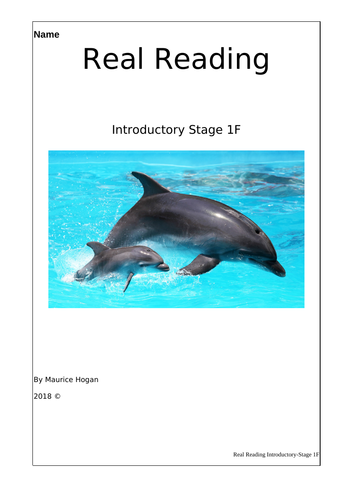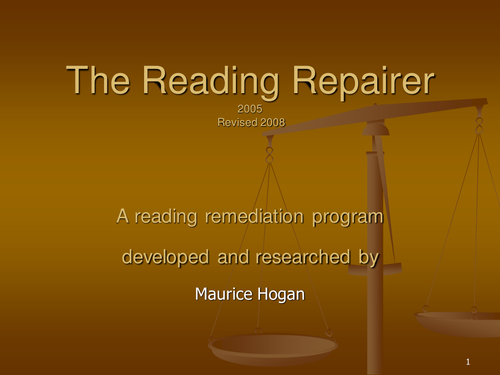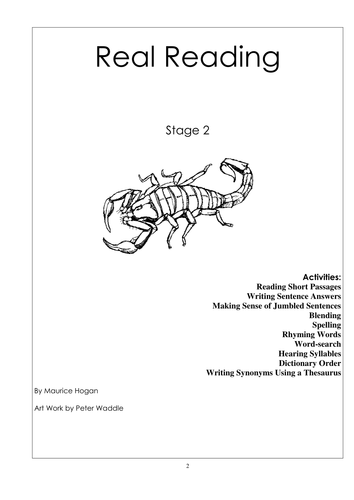
28Uploads
4k+Views
543Downloads
Special educational needs

Real Reading Introductory 1F
Real Reading Introductory levels are for older students who find it difficult to learn to read. This booklet provides written work that aims to teach students some Dolch sight words as well as how to write basic sentences. Much of this should enable each student to work independently.

Types of Word Problems
This unit contains 6 types of word problems with 10 of each type on a page to solve. This repetition of each type will assist students struggling to learn how to solve different types of word problems.

Tricky Maths Life Word Problems
For students to use their maths number skills they need to understand what processes to use in the real world. In this assignment students need to consider how to solve real world problems involving time, money and number.

The Reading Repairer PowerPoint
A PowerPoint detailing the content of The Reading Repairer and explaining why and how it should be helpful for teaching older students with poor reading skills. Helpful information for those considering using The Reading Repairer or alternative programs.

"The Clarke Road Money Program" PowerPoint
A PowerPoint detailing the major teaching points and strategies in The Clarke Road Money Program. This program is suitable for students across a very broad range - 3 levels. It is suitable for most students beginning with those who have little language and who are unable to read numbers. Clarke Road is a comprehensive Australian program at 3 levels developed in a Special School, which offers teachers a pathway to teaching all their students a way to learn to shop independently. This PowerPoint enables teachers to share the content of the programs.

Maths Story Problems diagnostic assessment
Story problems can be categorized into different types. This diagnostic tool enables you to discover which types of story problems your students are able to understand and solve, and those they still need further teaching on.

The Arithmetic Repairer Part 5 Division worksheets
This final section of The Arithmetic Repairer provides worksheets of the different types of division problems which are assessed in part 1 of The Arithmetic Repairer.

The Arithmetic Repairer Part 4 Multiplication worksheets
Multiplication type worksheets that match those in the diagnostic assessment in part 1 of The Arithmetic Repairer.

The Arithmetic Repairer Part 3 Subtraction worksheets
Subtraction worksheets that match the problem types in the diagnostic assessment in Part 1 of The Arithmetic Repairer. 45 pages.

The Arithmetic Repairer Part 2 Addition worksheets of different types of addition
The Arithmetic Repairer Part 2 presents addition type worksheets that match the diagnostic assessment in part 1. Several pages of each addition problem type are presented to provide adequate repetition of each problem type to assist with repetition and progress towards mastery.

The Arithmetic Repairer PART 1, Introduction, Assessment, Counting, etc
The Arithmetic Repairer Part 1 introduces this remediation package and includes a diagnostic assessment to pinpoint students' difficulties in basic arithmetic: counting, symbols and place value, addition, subtraction, multiplication and division. This section includes worksheets for those with deficits in counting and symbols and place value. Further parts of The Arithmetic Repairer provide the worksheets for the other areas within the diagnostic assessment tool. 70 pages.

Diagnostic Assessment of Analog Time Telling Skills
Use this tool to discover which analog time telling skills your students have and those they still need to be taught or have revised.

Screening test for Basic Arithmetic
A diagnostic test to discover what basic arithmetic skills your students have and still need to be taught. Includes: counting, symbols and place value, addition, subtraction, multiplication and division.

Real Reading Transition
Real Reading Transition provides more focussed attention on reading for a purpose and writing proper sentences within the animals theme. Basic phonics and sight words are emphasized and repetition assists students to master skills rather than only be exposed to them. This "transition level" equates to a little more challenging than level 2 in the series, but is easier than level 3.

Real Reading Stage 3
Information about various animals is presented and students use this information to answer questions using proper sentences. Repetition is used to reinforce basic sentence writing and phonics skill development. The second half of the workbook moves up a level in difficulty of reading and the expectations of what students will write. They are also required to rewrite challenging sentences, find more information about each animal and to use a thesaurus.

Real Reading Stage 2
A student workbook for older students struggling to learn phonics and write simple sentences. Brief information is given about animals and students need to answer questions using this information. In the process they improve their phonics, sight words and writing skills.

Real Reading Stage 1
A student booklet for older students who are struggling with literacy and require significant amounts of repetition. The emphasis is on learning basic phonics and sight words, plus developing sentence writing and basic punctuation skills.

Real Reading Introductory Stage 1B
Designed for older students who need further work with basic phonics - reading and writing letters as well as learning to write a sentence. Level 1B follows the same format as level 1A.

Real Reading Introductory Stage 1a
Designed for older students giving them independent work that teaches them basic beginning phonics and sight words as well as providing practise in writing a sentence.

The Reading Repairer, 8. VCe and Y Derivatives.
In booklet 8 of The Reading Repairer series the focus is upon teaching the decoding skills for words that are derived from vowel-consonant-e type words as well as those from Y-derived word types. Maintenance upon mastery learning and teaching generalizable skills is maintained through the use of graphs to measure daily progress. Word lists and 100 word passages maintain the consistent approach of the previous booklets in this series. Booklet 1 is highly recommended to facilitate teaching this remediation program well. 67 pages.




















